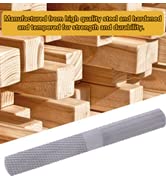What constitutes a joiner and why does it work in cabinetmaking
June 17, 2022

A joiner is a craftsman and merchant who constructs things by joining bits of wood, especially lighter and more fancy work than that done by a carpenter, including furniture and the “fittings” of a house, transport, etc. Joiners might work in a studio because the development of different joints is made simpler by the utilization of non-versatile, fueled hardware, or in the place of work. A joiner typically creates things like inside and outside entryways, windows, steps, tables, shelves, cabinets, furniture, and so on. In shipbuilding, a marine joiner might work with materials other than wood-like tile, fiberglass, equipment, and gaskets- best rotary tool for wood carving .
The terms joinery and joiner are in like manner used in the UK, Australia, and New Zealand. The term isn’t in that frame of mind in North America, albeit the primary worker’s organization for American carpenters is known as the United Brotherhood of Carpenters and Joiners of America.
In the UK, a student of wood occupations could decide to concentrate on seat joinery or site carpentry and joinery. Seat joinery is the readiness, setting out, and production of joinery parts while site carpentry and joinery center around the establishment of the joinery parts, and on the setting out and creation of wood components utilized in development.
History
Throughout the entire existence of innovation in Europe, joinery was the middle age improvement of the casing and board development, for of adapting to wood’s development attributable to dampness changes. Outlined board development was used in furniture making. The improvement of joinery led to “joiners”, a gathering of carpenters particularly the carpenters and arkwrights (arks were a middle stage between a carpenter’s boarded chest and an outlined chest).
The first feeling of joinery is simply indirectly connected with the cutting-edge practice of carpentry joints, which are crafted by carpenters. This new method was created north a few centuries and joiners began making more mind-boggling furniture and framed rooms. Cabinetmaking turned into its particular furniture-production exchange as well, so joiners (under that name) turned out to be more connected with the room framing exchange.
Cabinet making:
A cabinet is a case or pantry with racks or potentially drawers for putting away or showing things. A few cabinets remain solitary while others are worked into a divider or are joined to it like a medicine cabinet. Cabinets are normally made of wood (strong or with a facade or fake surfaces), covered steel (normal for medication cabinets), or manufactured materials. Business-grade cabinets as a rule have a melamine-particleboard substrate and are shrouded in a high-strain embellishing cover, normally alluded to as Wilsonart or Formica.
Cabinets some of the time have at least one entryway on the front, which is mounted with entryway equipment, and sporadically a lock. Cabinets might have at least one entryway, drawers, and additional retires. Short cabinets frequently have a completed surface on top that can be utilized for the show, or as a functioning surface, for example, the ledges tracked down in kitchens.
A cabinet planned to be utilized in a room and with a few drawers regularly positioned one over one more in at least one segment expected for the dress and little articles is known as a dresser or a bureau. A little bedside cabinet is all the more as often as possible called an end table or night table. A tall cabinet expected for dress capacity including the hanging of garments is known as a closet or an armoire, or a wardrobe whenever worked in.
By the level of art carpentry (late eighteenth hundred years), carpenters, joiners, and cabinetmakers were all particular and would serve various apprenticeships.

In British English, a joiner is conversationally known as a “chippy”.
